What's inside
What's inside
 Key Ingredients
Key Ingredients

No key ingredients
 Benefits
Benefits

 Concerns
Concerns

 Ingredients Side-by-side
Ingredients Side-by-side

Water
Skin ConditioningCetyl Ethylhexanoate
EmollientCetearyl Alcohol
EmollientHydroxypropyl Bispalmitamide Mea
EmollientHuman Neonatal Fibroblast Conditioned Media
Skin ConditioningDimethicone
EmollientOlea Europaea Fruit Oil
MaskingGlycine Soja Oil
EmollientGlycerin
HumectantCetearyl Glucoside
EmulsifyingPalmitoyl Oligopeptide
CleansingPalmitoyl Tetrapeptide-7
Skin ConditioningTetrahexyldecyl Ascorbate
AntioxidantAvena Sativa Kernel Extract
AbrasiveGlycine Soja Sterols
EmollientRetinyl Palmitate
Skin ConditioningTocopheryl Acetate
AntioxidantSodium Carboxymethyl Beta-Glucan
CleansingSqualane
EmollientAllantoin
Skin ConditioningBisabolol
MaskingPanthenol
Skin ConditioningSodium Hyaluronate
HumectantXanthan Gum
EmulsifyingGlyceryl Stearate
EmollientPEG-100 Stearate
Isoceteth-20
EmulsifyingButylene Glycol
HumectantEthoxydiglycol
HumectantCarbomer
Emulsion StabilisingDisodium EDTA
Ethylhexylglycerin
Skin ConditioningPhenoxyethanol
PreservativeCaprylyl Glycol
EmollientCaprylhydroxamic Acid
Potassium Sorbate
PreservativeWater, Cetyl Ethylhexanoate, Cetearyl Alcohol, Hydroxypropyl Bispalmitamide Mea, Human Neonatal Fibroblast Conditioned Media, Dimethicone, Olea Europaea Fruit Oil, Glycine Soja Oil, Glycerin, Cetearyl Glucoside, Palmitoyl Oligopeptide, Palmitoyl Tetrapeptide-7, Tetrahexyldecyl Ascorbate, Avena Sativa Kernel Extract, Glycine Soja Sterols, Retinyl Palmitate, Tocopheryl Acetate, Sodium Carboxymethyl Beta-Glucan, Squalane, Allantoin, Bisabolol, Panthenol, Sodium Hyaluronate, Xanthan Gum, Glyceryl Stearate, PEG-100 Stearate, Isoceteth-20, Butylene Glycol, Ethoxydiglycol, Carbomer, Disodium EDTA, Ethylhexylglycerin, Phenoxyethanol, Caprylyl Glycol, Caprylhydroxamic Acid, Potassium Sorbate
 Reviews
Reviews

Ingredients Explained
These ingredients are found in both products.
Ingredients higher up in an ingredient list are typically present in a larger amount.
Allantoin is a soothing ingredient known for its protective and moisturizingg properties. Because of this, it is often added to products with strong active ingredients.
Studies show higher concentrations of this ingredient can promote wound healing.
Though it can be derived from the comfrey plant, allantoin is produced synthetically for cosmetic products to ensure purity.
Learn more about AllantoinGlycerin is already naturally found in your skin. It helps moisturize and protect your skin.
A study from 2016 found glycerin to be more effective as a humectant than AHAs and hyaluronic acid.
As a humectant, it helps the skin stay hydrated by pulling moisture to your skin. The low molecular weight of glycerin allows it to pull moisture into the deeper layers of your skin.
Hydrated skin improves your skin barrier; Your skin barrier helps protect against irritants and bacteria.
Glycerin has also been found to have antimicrobial and antiviral properties. Due to these properties, glycerin is often used in wound and burn treatments.
In cosmetics, glycerin is usually derived from plants such as soybean or palm. However, it can also be sourced from animals, such as tallow or animal fat.
This ingredient is organic, colorless, odorless, and non-toxic.
Glycerin is the name for this ingredient in American English. British English uses Glycerol/Glycerine.
Learn more about GlycerinWater. It's the most common cosmetic ingredient of all. You'll usually see it at the top of ingredient lists, meaning that it makes up the largest part of the product.
So why is it so popular? Water most often acts as a solvent - this means that it helps dissolve other ingredients into the formulation.
You'll also recognize water as that liquid we all need to stay alive. If you see this, drink a glass of water. Stay hydrated!
Learn more about Water